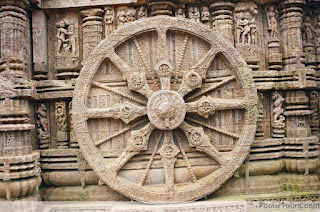 |
| Time Wheel, Sun temple of Konarak, Orissa, |
 | |
Indian monuments,
|
Across India lies a vast and diverse pool of historical and cultural heritage, and ancient monuments running into thousands that include places of worship - Hindu, Christian and Islam, historical forts, palaces, colonial buildings, bungalows, etc spanning several centuries. The sheer number of these historical heritage sites is just mind-boggling. They are the epitome of our past social, political and religious history, besides the growth of our culture, ethos and tradition. They are as old as the development of the Indus Valley civilization, hence the culture is diverse and the history antiquated. .
According to the ASI, ''Ancient Monument means any structure, erection or monument, or any tumulus or place of interment, or any cave, rock-sculpture, inscription or monolith which is of historical, archaeological or artistic interest and which has been in existence for not less than 100 years”.
 |
| India. canstockphoto.com |
 |
| Indian monuments. clipartstation.com |
Giving due attention to the preservation of countless monuments of grandeur and beauty for the posterity, in February 2020 the Central Government made a right decision to increase the number of monuments to 10000.on its list, a move well received by heritage lovers. The government will also review those monuments under the protection of the state. The ASI, presently protects only 3,691 monuments nationwide. The Uttar Predesh state has the largest sites under the ASI. This information was given by the Union Minister for Culture Prahlad Singh Patel in the second week of February this year.
In the last several years the list of centrally controlled monuments remained static. Only recently, the monuments across the country had been reviewed and based on their cultural and historical value the list was increased manifold. It is said some monuments from the central list will be removed and transferred to the states for adequate protection. In Tamil Nadu alone there are 7000 temples many of which are pretty old and need protection because many of them have beautifully made stone sculptures and metal idols, besides jewelry. In TN, a large section of the people is not happy about the way the govt agency HR & CE runs the managements of historical temples and their vast properties. Against the govt agency, there have been many cases of financial mismanagement, illegal sale of temple lands and thefts of antique idols and these disparaging activities peaked during the DMK rule.
The ASI has already enforced the ban on construction within 100 metres radius of a Centrally protected monument and regulated construction within 100-200 metres under the Ancient Monuments and Archaeological Sites and Remains Act, 1958. The Act protects monuments and sites that are over 100 years old. In addition to strict law enforcement, the state and Central governments should come up with social awareness programs on the importance of historical sites and their preservation for the posterity so that they can pass it on to the next generation of people.
Cleanliness drives in and around the monuments, adequate lighting, proper access roads, proper security, periodic surveys, putting up strong barricades around the sites, stringent laws against law-breakers, proper documentation of the sites, voluntary contribution and adoption of monuments and heritages by responsible private individuals or trusts and above all, setting up a grievances cell for each monument will go a long way and preserve our heritage sites. Regarding already neglected monuments or monuments that face real danger, steps should be takenon a war-footing to save them from total destruction.
https://www.youthkiawaaz.com/2011/03/how-to-protect-national-heritage/









